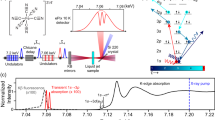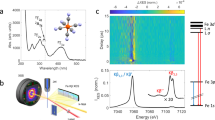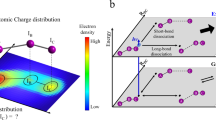Abstract
Aqueous ions are central to catalysis and biological function and play an important role in radiation biology as sources of damage-inducing electrons. Detailed knowledge of solute–solvent interactions is therefore crucial. For transition-metal ions, soft X-ray L-edge spectroscopy allows access to d orbitals, which are involved in chemical bonding. Using this technique, we show that the fluorescence-yield spectra of aqueous ionic species exhibit additional features compared with those of non-aqueous solvents. Some features dip below the fluorescence background of the solvent and this is rationalized by the competition between the fluorescence yields of the solute and solvent species, and between the solute radiative (fluorescence) and non-radiative channels; in particular, electron transfer to the water molecules. This method allows us to determine the nature, directionality and timescale of the electron transfer. Remarkably, we observe such features even for fully ligated metal atoms, which indicates a direct interaction with the water molecules.
This is a preview of subscription content, access via your institution
Access options
Subscribe to this journal
Receive 12 print issues and online access
$259.00 per year
only $21.58 per issue
Buy this article
- Purchase on Springer Link
- Instant access to full article PDF
Prices may be subject to local taxes which are calculated during checkout



Similar content being viewed by others

Change history
29 June 2017
We the authors are retracting this Article as we are unable to explain the presence of data in three of the spectra; namely, Figure 2a (hemin in ethanol) and Figure 2c ([Fe(bpy)3]2+ in water and in acetonitrile). The spectra in Figures 2a and 2c feature data in the 730 eV to 735 eV region that appear to have been duplicated from other regions of the spectra. We are unable to provide raw data for this region for any of the three spectra and we are unable to attempt to reproduce the spectra under the same conditions originally reported because the original beamline (U41-PGM) that we have used to conduct these experiments has been dismantled. The data integrity issues undermine our full confidence in the integrity of the study and we therefore wish to retract the Article.
References
Fraústo da Silva, J. R. R. & Williams, R. J. P. The Biological Chemistry of the Elements: The Inorganic Chemistry of Life (Oxford Univ. Press, 1991).
Wöhrle, D. & Pomogaïlo, A. D. Metal Complexes and Metals in Macromolecules: Synthesis, Structure, and Properties (Wiley-VCH, 2003).
Lehnert, S. Biomolecular Action of Ionizing Radiation (Taylor & Francis, 2008).
Stöhr, J. NEXAFS Spectroscopy (Springer, 1992).
De Groot, F. & Kotani, A. Core Level Spectroscopy of Solids (Taylor & Francis, 2008).
Bonhommeau, S. et al. Solvent effect of alcohols at the L-edge of iron in solution: X-ray absorption and multiplet calculations. J. Phys. Chem. B 112, 12571–12574 (2008).
Aziz, E. F. et al. Direct contact versus solvent-shared ion pairs in NiCl2 electrolytes monitored by multiplet effects at Ni(II) L edge X-ray absorption. J. Phys. Chem. B 111, 4440–4445 (2007).
Aziz, E. F. et al. Probing the electronic structure of the hemoglobin active center in physiological solutions. Phys. Rev. Lett. 102, 68103 (2009).
Bergmann, N. et al. On the enzymatic activity of catalase: an iron L-edge X-ray absorption study of the active centre. Phys. Chem. Chem. Phys. 12, 4827–4832 (2010).
de Groot, F. M. F. et al. Fluorescence yield detection: Why it does not measure the X-ray absorption cross section. Solid State Commun. 92, 991–995 (1994).
Van Elp, J. et al. Electronic structure and symmetry in nickel L edge X-ray absorption spectroscopy: application to a nickel protein. J. Am. Chem. Soc. 116, 1918–1923 (1994).
Pompa, M. et al. Experimental and theoretical comparison between absorption, total electron yield, and fluorescence spectra of rare-earth M5 edges. Phys. Rev. B 56, 2267–2272 (1997).
Näslund, L. A. et al. Direct evidence of orbital mixing between water and solvated transition-metal ions: an oxygen 1s XAS and DFT study of aqueous systems. J. Phys. Chem. A 107, 6869–6876 (2003).
Eisebitt, S. et al. Determination of absorption coefficients for concentrated samples by fluorescence detection. Phys. Rev. B 47, 14103 (1993).
Nakajima, R., Stohr, J. & Idzerda, Y. U. Electron-yield saturation effects in L-edge X-ray magnetic circular dichroism spectra of Fe, Co, and Ni. Phys. Rev. B 59, 6421–6429 (1999).
Hocking, R. K. et al. Fe L-edge XAS studies of K4[Fe(CN)6] and K3[Fe(CN)6]: a direct probe of back-bonding. J. Am. Chem. Soc. 128, 10442–10451 (2006).
Aziz, E. F., Zimina, A., Freiwald, M., Eisebitt, S. & Eberhardt, W. Molecular and electronic structure in NaCl electrolytes of varying concentration: identification of spectral fingerprints. J. Chem. Phys. 124, 114502 (2006).
Krause, M. O. & Oliver, J. H. Natural widths of atomic K and L levels, Kα X-ray lines and several KLL Auger lines. J. Phys. Chem. Ref. Data 8, 329–339 (1979).
Vigliotti, F. et al. Rydberg states in quantum crystals NO in solid H2 . Faraday Discuss. 108, 139–159 (1997).
Aziz, E. F., Ottosson, M., Faubel, N., Hertel, I. V. & Winter, B. Interaction between liquid water and hydroxide revealed by core-hole de-excitation. Nature 455, 89–91 (2008).
Eggleston, C. M., Ehrhardt, J. J. & Stumm, W. Surface structural controls on pyrite oxidation kinetics: an XPS-UPS, STM, and modeling study. Am. Mineral. 81, 1036–1056 (1996).
Nesbitt, H. W. et al. Identification of pyrite valence band contributions using synchrotron-excited X-ray photoelectron spectroscopy. Am. Mineral. 89, 382–389 (2004).
Ohno, M. & van Riessen, G. A. Hole-lifetime width: a comparison between theory and experiment. J. Electron Spectrosc. 128, 1–31 (2003).
Aziz, E. F., Freiwald, M., Eisebitt, S. & Eberhardt, W. Steric hindrance of ion–ion interaction in electrolytes. Phys. Rev. B 73, 075120 (2006).
Vinogradov, A. S. et al. Observation of back-donation in 3d metal cyanide complexes through N K absorption spectra. J. Electron Spectrosc. 114, 813–818 (2001).
Moret, M. E., Tavernelli, I. & Röthlisherger, U. Combined QM/MM and classical molecular dynamics study of [Ru(bpy)3]2+ in water. J. Phys. Chem. B 113, 7737–7744 (2009).
Kim, P. S. et al. X-ray excited optical luminescence studies of tris-(2,2′-bipyridine)ruthenium(II) at the C, N K-edge and Ru L3,2-edge. J. Am. Chem. Soc. 123, 8870–8871 (2001).
Heigl, F., Lam, S., Regier, T., Coulthard, I. & Sham, T.-K. Time-resolved X-ray excited optical luminescence from tris(2-phenylbipyridine)iridium. J. Am. Chem. Soc. 128, 3906–3907 (2006).
Cannizzo, A. et al. Broadband femtosecond fluorescence spectroscopy of [Ru(bpy)3]2+. Angew. Chem. Int. Ed. 45, 3174–3176 (2006).
Tarnovsky, A. N., Gawelda, W., Johnson, M., Bressler, C. & Chergui, M. Photexcitation of aqueous ruthenium(II)-tris-(2,2′-bipyridine) with high-intensity femtosecond laser pulses. J. Phys. Chem. B 110, 26497–26505 (2006).
Schnadt, J. et al. Experimental evidence for sub-3-fs charge transfer from an aromatic adsorbate to a semiconductor. Nature 418, 620 (2002).
Fontana, I., Lauria, A. & Spinolo, G. Optical absorption spectra of Fe2+ and Fe3+ in aqueous solutions and hydrated crystals. Phys. Status Solidi B 244, 4669–4677 (2007).
Acknowledgements
We thank F. de Groot for discussions. This work was supported by the Helmholtz-Gemeinschaft (the young investigator fund VH-NG-635), the Swiss National Science Foundation (grants 200021-116533/1 and IZK0Z2-126024) and the Swiss State Secretariat for Education and Research (COST CM0702). M.C. is grateful to the Alexander von Humboldt Foundation for support.
Author information
Authors and Affiliations
Contributions
E.F.A. conceived and designed the experiments, E.F.A, M.H.R.F. and K.M.L. performed the experiments, E.F.A., S.B. and M.C. analysed the data and E.F.A. and M.C. co-wrote the paper.
Corresponding authors
Ethics declarations
Competing interests
The authors declare no competing financial interests.
Supplementary information
Supplementary information
Supplementary information (PDF 626 kb)
Rights and permissions
About this article
Cite this article
Aziz, E., Rittmann-Frank, M., Lange, K. et al. Charge transfer to solvent identified using dark channel fluorescence-yield L-edge spectroscopy. Nature Chem 2, 853–857 (2010). https://doi.org/10.1038/nchem.768
Received:
Accepted:
Published:
Issue Date:
DOI: https://doi.org/10.1038/nchem.768
This article is cited by
-
Correction: Retraction: Charge transfer to solvent identified using dark channel fluorescence-yield L-edge spectroscopy
Nature Chemistry (2017)
-
Correction: Retraction: Transferring electrons to water
Nature Chemistry (2017)
-
Joint Analysis of Radiative and Non-Radiative Electronic Relaxation Upon X-ray Irradiation of Transition Metal Aqueous Solutions
Scientific Reports (2016)
-
Dark channel fluorescence observations result from concentration effects rather than solvent–solute charge transfer
Nature Chemistry (2012)
-
Dips and peaks in fluorescence yield X-ray absorption are due to state-dependent decay
Nature Chemistry (2012)


